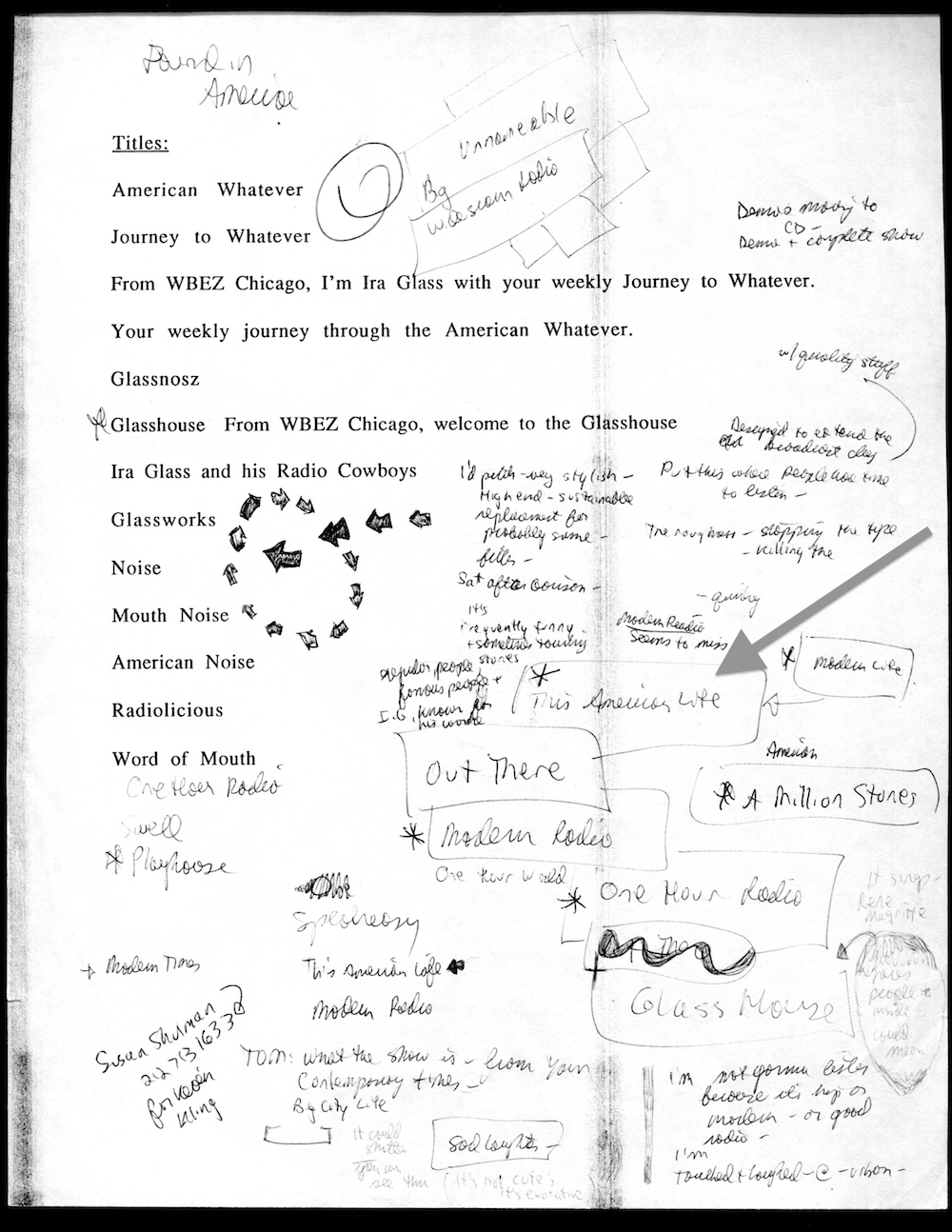
Ask Ira Glass what it's like to be nearing the 500th episode of his beloved public radio show This American Life, and he gives a classic Ira Glass-ian answer.
"Honestly, it feels to me more like an odometer rolling over than anything else," he says before a quick pause of contemplation. "But I think it's because I'm not built very well for self-congratulation."
By any metric, what Glass has done on public radio for the past 17-plus years is impressive. This American Life, his hour-long show of stories centered around a single theme, has employed everything from hard-hitting investigative journalism about the fallout from the 2008 financial crisis to short works of fiction about a duck falling in love with a rock. The show has gone on a multi-city tour, and broadcast live into movie theaters across the country. In 2007 and 2008, Glass produced an Emmy-winning TV version of This American Life for Showtime — and then walked away from it because, as explained on the show's site, "it was too much work doing both the radio and television shows." And last year, Glass co-wrote and produced his first feature film based on a story on This American Life, director Mike Birbiglia's Sleepwalk with Me.
And this Friday, This American Life will broadcast its 500th hour. Its popularity shows no sign of waning with age: Its podcast sits consistently at the top of the iTunes charts, averaging 850,000 downloads a week, on top of its 1.8 million radio listeners.
"It feels like, 'Oh, we're totally solid as a show,'" says Glass, continuing to insist that broadcasting 500 shows isn't a huge deal. "I don't have very bask-y feelings in general about many things, and I feel like maybe if I were psychologically a little better adjusted, I could have that about this, but for whatever reason, I don't. Truthfully, I think if the show weren't going well right now, this'd be a moment where I would be feeling a tremendous amount of nostalgia for the early days of the radio show. But I feel like the last two years or so of the show have been the best, just in terms of the number of good shows and the variety of things we've done and the ambition of things we've done. I don't feel myself looking back very often. Including now, when it would be appropriate to."
That said, Glass was nonetheless game to look back on some of the episodes that stand out in his mind as particularly meaningful or memorable to him, for better or, perhaps, for worse. "As I've gone into this process of thinking about the shows that I feel the most attached to," he says, "I wish that I weren't this sort of person, but I think I am, where the ones that I feel the most strongly about are ones I have some strong personal connection to" — including the very first episode, broadcast on Nov. 17, 1995.
Episode #1: "New Beginnings"

In the early days of the shows, Glass' parents were frequent interview subjects — which changed his relationship with them.
"When I started the show, things were a little bit on the chilly side between me and them, partly because they disapproved of everything I was doing with my life," he says. "They thought I should get out of public radio and didn't understand why I was starting the show."
But as the program became a hit, tensions between them eased.
"We really resolved any problems that we had with each other. I think they would say the same thing, and I never would have expected that when I started the radio show," he says. "That was not a goal of the show at all. It was a completely surprising side product, and some of the early interviews I do with them on the show, especially with my mom, who's now dead — she's on the first episode of the show being very, very mom-like — I feel like are some of the moments that mean the most to me."
BONUS: This American Life's first episode was broadcast only on WBEZ in Chicago with the show's original title, Your Radio Playhouse. As the program began to syndicate to other stations, Glass realized that its title was not very good. The below "artifact" (Glass' word) is his notes from the meeting where Glass and his staff renamed the show starting with the episode airing March 21, 1996.

Episode #199: "The House on Loon Lake"

The flexible format of This American Life cuts both ways — it allows its producers to approach telling a story from almost any direction, but it also makes for lots of false starts.
"That certainly happens," says Glass. "Often, we'll just kill the story, or we'll just take the one part we like. You know, this thing we thought was gonna be an 18-minute epic fable, there's just this one good moment that becomes a little, three-minute top to the episode."
Sometimes, though, the show will get so deep into a story without knowing the outcome that they're pretty much committing to following through on it no matter what. Even if the story ends up, as Glass puts it, as a "real disappointment."
Like "The House on Loon Lake."
In the episode, Adam Beckman — the husband of one of the show's producers — tells the story of an abandoned home in a small New England town Beckman's family visited every summer. "What was crazy about this house was that everything had been left as it was," says Glass. "Literally, there's a wallet sitting on a bureau with money in it. There was food in the kitchen. It was like aliens had come in and airlifted out the people and left all their stuff right there, and it hadn't been looted. … They started to find letters and things, and tried to reconstruct what had happened. At some point they find a matchbook with the address of a store, and it's the same name of the family that owned the house, the Nathan family, and they go to this address, and they find an entire store that's like this, with products on the shelves that have been there for decades."
It was a perfect hook for a This American Life story, so the show followed Beckman back to the town to discover what had happened. But the truth turned out to be much less interesting than anything Glass had imagined.
"Some people died, and there was an argument over the estate, and the tax man was involved. Nobody could take the house or own it because all these people were fighting over it in court. The answer to the mystery is so much more boring than the mystery," says Glass. "Then you just say, 'Well, I don't know. Should we even broadcast this?' It's so unsatisfying. It's only through some sort of weird finesse that people even can stand it. Sometimes the problem is the facts simply don't live up to what you would want them to, and you're stuck with the facts."
Episode #206: "Somewhere in the Arabian Sea"

Just a few months after 9/11, Glass and producers Wendy Dorr and Alex Blumberg embedded themselves on the USS John C. Stennis, an aircraft carrier in the Arabian Sea supporting the early days of the conflict in Afghanistan. But rather than take on the war on terror from a sober, political perspective, Glass and his team tried a different tactic: humor.
"That's a show I feel very proud of," says Glass, "just because we take on the war, but in a way where everyone who we talked to, from the sailors to the people filling the vending machines, seem like people who you would know in a way that is unheroic and uncorny and just very funny. There were a lot of really funny people on that ship. I feel like it just gave a different sense of what it means to be in the military in that war than I think we saw in a lot of places. One of the funnier hours, I think, in the war on terror, for sure. For American journalism."
Episode #400: "Stories Pitched by Our Parents"

The last time This American Life hit a major milestone, Glass says he and his staff decided to attempt "the hardest thing" they could think of — a show based on pitches from their parents.
"Like, your parents say, 'Why don't you do a story on this?' And [normally] we're like, 'Those stories are so not right for radio,'" says Glass. For the 400th episode, however, they tried to make these stories work for the radio anyway. "Truthfully, that was incredibly hard," Glass says with a chuckle. "We did it as a contest with each other, like, who can actually execute the best these not-great ideas? I remember [producer] Nancy [Updike]'s dad wanted to do a story about the Erie Canal, and you just think, like, the Erie Canal. Really? Like we're gonna do a story about that?" (The trophy in the above photo went to producer Robyn Semien, the winner of the contest as voted on by over 13,000 listeners, for her story about her father's unique electronic modification to his car.)
Episode #430: "Very Tough Love"

"Unless you work for 60 Minutes," says Glass, "your life is: You do stories about things and nothing happens as a result."
Except this one time when it did.
In 2010, Glass stumbled upon the story of Superior Court Judge Amanda Williams, and her eyebrow-raising tenure running the "drug courts" — i.e., special courts for drug-related offenses — for Glynn, Camden, and Wayne counties in Georgia. Judge Williams, Glass learned, appeared to have a history of handing down enormously harsh sentences for relatively minor offenses, a practice that cut against what practically every other drug court in the country was doing. "When I learned about the story," says Glass, "I totally had a feeling of, 'God, some reporter should really look into this.' And then I felt like, 'Oh, I guess I'm a reporter.' You know? 'I guess that I should be the reporter to do this.'"
But Williams was such a powerful figure within the community that Glass found it nearly impossible to nail down the facts about her. "It took me months before I was able even to ascertain that what I was being told was true," says Glass. "And during that period, really, I think everyone in my life was very skeptical that there would ever be a story. I would fly down to Georgia for the fourth or fifth time, and my whole staff would just roll their eyes. Like, 'What are you doing?'"
The story first ran on March 25, 2011, and within the year, Judge Williams left the bench for good. "At the same time that I was [in Georgia], something called the Judicial Qualifications Commission was looking into her," says Glass. "The presence and visibility of the radio show about her — I know this is true because I've talked to people now who were part of that process — raised the profile of that case and kind of expedited it. They brought charges against her, and she stepped down from office."
Originally, this two-part episode — for which three reporters spent five months in a high school on the South Side of Chicago where 29 current and recent students had gotten shot the previous school year — wasn't supposed to be about a high school at all.
"My senior producer Julie Snyder was really interested in figuring out a way to cover all the murders going on in Chicago last year," says Glass. "The first thing she came up with was last Memorial Day, over 50 people were shot in Chicago. Julie was just like, 'That's horrible, but that's our angle in. Let's just do the story of Who were these 50 people? What were these 50 shootings about?'" That proved unproducible because a) Several of those cases were tied up in criminal proceedings where none of the involved parties could talk on the record, and b) Hearing about the deaths of 50 people is super repetitive and depressing.
Instead, a story out of This American Life's home station WBEZ about a single gun-related death in Chicago really caught their attention. A local education reporter named Linda Lutton had gone to a funeral for a student named Shakaki Asphy, and Snyder and Glass were especially taken with the principal at Asphy's high school, Leonetta Sanders, who played a central role in Lutton's story. "The principal shows [Lutton] this binder that she had been keeping for a year of all the kids in her school who had been shot, and I think at that point it was 27 kids," says Glass. "She was so emotional and real, and also very thoughtful, very analytical about what was going on. We thought, 'Well, what if we just do this school?'"

The result was one of the most riveting and moving stories This American Life has ever broadcast, somehow capturing both the larger issues behind all the violence dominating the lives of everyone in the area and illuminating the personal, emotional stories of the students and staff within the school.
"What was great about Harper is the staff was super competent," says Glass. "Because there were so many shootings, they had trained in how to jump into action when a kid got shot, to prevent the next shooting. The kind of journalism we're doing, we don't just need characters; we need the forward motion of suspense and plot, and that gave us plot. So that when a kid got shot the week of homecoming, the day of the pep rally — during the pep rally — the reporters could just record the staff, and we, like they, experienced the suspense of, 'Well, what is gonna happen now?'"
That shooting also solved another problem — the team had collected so much reporting, Glass decided the story should unfold over two episodes. But, says Glass, he and his staff "really feared that after one episode of it, every single person in the audience would feel like, 'OK, I'm good. I don't need to go back to this murderous school for a second week.'" Their solution: Build in a cliff-hanger centered around whether Principal Sanders would cancel the homecoming dance because of the shooting.
"It was a tactical thing," says Glass. "I think in a lot of these stories, with the more serious material, one of the things that's so difficult is figuring out how to get people to listen at all, you know what I mean? In those cases, I feel like we've tried very hard not just to come up with stories in our style, but also to be cunning about how we're signaling to you, 'No, no, no, we're gonna take you into this in some way that's different' — and often really delay telling you what the show is about, if that doesn't sound manipulative. Though it is."
Episode #492: "Dr. Gilmer and Mr. Hyde"

In sharp contrast to "The House on Loon Lake," this was a show in which the initial story seemed like it was never going to amount to anything at all. It all started with a physician named Dr. Benjamin Gilmer, a new doctor at a small town clinic in North Carolina, who was unsettled to learn that the beloved doctor he replaced in the practice was not only named Dr. Gilmer — Dr. Vince Gilmer, no relation — but this earlier Dr. Gilmer was in prison for the brutal murder of his own father.
This American Life producer Sarah Koenig began following Dr. Benjamin Gilmer's investigation into the mysterious details of what led Dr. Vince Gilmer to such a heinous act — but the more they looked, the less they seemed to find. "We all thought, 'This is gonna go nowhere,'" says Glass. In fact, over the course of the episode, Glass kept reassuring listeners that they would be arriving somewhere interesting. Because, eventually, they did.
"They actually cracked the case over the course of it, while they're rolling tape," says Glass. "They figure out, 'Oh, wait a second, the way he was convicted, if all the facts came forward, he probably would not get convicted today.' That's just an incredible thing to have happened. Obviously, we got very, very lucky that the story turned out to be as interesting as it did, and I feel like it's just a testament to the number of stories that we do, that we could kind of pitch the ball enough times that occasionally something happens like that. That's just dumb luck, and a tribute to Sarah, that she would just launch into that story just figuring, 'Well, I don't know. I'm kind of interested. I like this guy. Let's just see where it goes.'"
Episode #500: "500!"

For the show's 500th episode, airing Friday, Glass wasn't sure at first if they should do anything special at all. "One weird thing about doing a 500th show is it's like we got an assignment, and what we got the assignment from is numbers themselves," Glass says with a laugh. "So that's also kind of a strange thing."
Initially, the staff batted around the idea of doing a story on what Glass only calls "an iconic building," and each story would be located in a different room of that building. But they couldn't make the story work by their deadline, so they decided instead to do a show on This American Life itself.
"The thing that seemed like it would be the most fun," says Glass, "was to just go back and have the staff pick favorite moments from the last 499 episodes and talk about why they're the favorite. I think that the reason why they pick certain shows is really different from the way that listeners would pick them, and that's actually made for a really nice mix of things. It's a really nice, fun show."
So does Glass think he has another 500 episodes left in him?
"I mean, I guess," he says, after a long pause. "I don't know. I'm in my fifties, and I started the show 18 years ago. So if we would do them at exactly the same pace, I would be 72 when we hit 1,000. And I feel like, I don't know? If I'm alive? It's not like I've got anything more interesting going. It's a really unusually flexible and fun job. I work with people I like and get to do what I want. But I could also imagine getting tired of it and letting everybody else do the show without me. And I decide to become a screenwriter/hermit/public school teacher/recluse/baker. I'm trying to think of the corniest thing I could possibly think of. What's the corniest thing that a person would do when they stop? It's like going to a small town and starting a small-town paper/moving to the Florida Keys and just getting a boat, and living on the boat, and solving crimes."
He laughs. "I feel like in general in my work life, my main goal has been to just be in a situation where I'm not bored with my job. That's been the entire principle. Got my wish."

